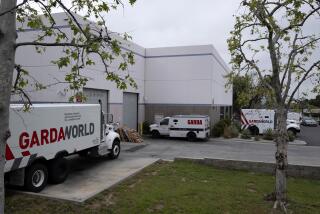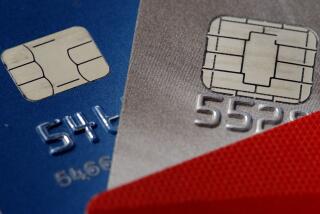As Y2K Fears Subside, So Do Cash Demands
- Share via
With only six days left before 2000, the long-feared cash-hoarding by Americans has so far failed to materialize and banks say most of their money is still in vaults, not in cookie jars or under mattresses.
Anticipating a heightened demand for cash because of year 2000 fears, U.S. banks have more than doubled the amount of currency in their vaults during the past three months, to a record $21.4 billion. But so far, most of it is still sitting there.
Withdrawals are up over the past month, but banks say the activity falls within the normal range they see during the year-end holiday season, when cash withdrawals typically increase between 10% and 30%.
“It’s not turning out the way we feared,” said Rob Haus, manager of year 2000 compliance for Minneapolis-based U.S. Bancorp. “We would have thought if there was going to be a serious problem, it would have happened by now.”
Bank of America said that cash withdrawals--which typically rise at its branches by about 7% to 10% as consumers shop and travel during the holidays--are up about 10% through this week.
“It’s on the high end of what we usually see, but within the norm,” said Chuck Wolski, who heads western branch operations for the Charlotte, N.C.-based bank.
But bank officials will be closely monitoring customer activity in the coming days, looking for signs of a last-minute stampede.
“The next two weeks are going to be key,” Wolski said.
Government statistics released Thursday show that total U.S. currency in circulation topped $512.5 billion as of Dec. 13 and has grown over the past two months at its fastest clip since the Gulf War.
Since November, currency in circulation has soared to an annualized growth rate of about 14%, or twice as fast as normal for this time of year. So far this month, currency in circulation has surged more than $7 billion from November, the highest monthly jump in memory.
So, if Americans aren’t hoarding cash, who is?
Foreign governments, businesses and citizens likely account for much of the activity so far, experts say, as Y2K concerns in other countries spur a flight to the relative safety of U.S. dollars.
“Two-thirds of U.S. currency is used overseas,” said Peter Bakstansky, senior vice president of the Federal Reserve Bank of New York. “It’s an important component. It’s hard to separate what is going on domestically with what is going on overseas.”
Foreign demand also fueled the currency spikes in 1991 during the Gulf War, said David Resler, chief economist for Nomura Securities International in New York.
U.S. banks clearly were bracing for much higher demand at home as the millennium approached and Americans became more concerned about potential Y2K computer glitches.
Beginning in September, U.S. banks began stockpiling extra cash to prepare. Surplus vault cash--which represents the amount of cash on hand that banks feel they need to meet public demand--is currently three times normal limits, according to Federal Reserve figures.
“We’re really no different than a manufacturer trying to manage inventory of goods,” said John Beal, a spokesman at City National Corp., the Beverly Hills-based bank. “We started working earlier this year to predict the demand 1/8for cash 3/8 of our customers.”
City National, for example, boosted its vault cash by about 50%, Beal said. So far, only a handful of customers have made sizable withdrawals, most frequently because they planned to travel abroad during the holiday, he said.
Along with the higher cash levels has come beefed-up security at several banks, including additional guards and other surveillance systems.
Banks, which typically try to carry only as much cash as they need, are concerned that their branches might became targets for robbery.
So cash that is not withdrawn by early January will be returned to the Federal Reserve Bank, which has printed an extra $50 billion to meet potential Y2K demand.
“At some point, we’ll end up sending it back to the Fed,” said Bob Trujillo, head of branches for San Francisco-based California Federal Bank.
Consumer surveys confirm that Americans today are less concerned about Y2K computer problems and less likely to withdraw cash than they were earlier this year.
A Gallup poll this month found 44% of consumers said they were likely to withdraw extra cash because of Y2K, down from 62% in March.
The dollar amount is also falling. More than half who said they might withdraw money plan to take out less than $500. Only 21% plan to withdraw more than $1,000, according to the poll, taken in mid-December.
“Confidence has been building,” said Dan Conway, the Y2K spokesman for Wells Fargo Bank. The San Francisco-based bank noticed an unusual surge in withdrawals during the spring, but said activity as of this week was within normal limits.
Many consumers say that they are less worried about the effect of Y2K on their finances.
Earlier this year, Orange County bankruptcy attorney William Lobel predicted Y2K would wreak havoc on financial markets. Now he regrets shifting some of his assets from the stock market to bonds, where they have earned much less.
In the spring, Lobel’s wife withdrew some cash to prepare for Y2K, but now the family doubts they will need it.
“I don’t perceive this as a big risk anymore,” Lobel said.
Several banks say they attempt to talk to customers requesting a large Y2K-related withdrawal, informing the consumers about the banks’ internal preparations and raising security concerns about holding a large amount of money.
“The first thing we do is try to talk them out of it,” Haus said.
In several cases, branch managers have persuaded customers to keep the money at a safe-deposit box or accept a travelers or cashier’s check.
(BEGIN TEXT OF INFOBOX / INFOGRAPHIC)
Stashing Cash?
U.S. banks have stocked their vaults with a record amount of cash in anticipation of heightened consumer demand because of year 2000 fears.
*
Surplus Cash Held in U.S. Bank Vaults (in billions) $21.4 billion
*
Currency in Circulation Monthly increase* (in billions) $7.3 billion Estimated as of Dec. 13
*
The amount of U.S. cash circulating worldwide is also growing, though not as sharply.
*
*Based upon the currency component of the Federal Reserve’s M1 numbers.
Source: Federal Reserve
More to Read
Sign up for Essential California
The most important California stories and recommendations in your inbox every morning.
You may occasionally receive promotional content from the Los Angeles Times.










